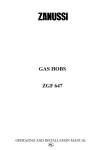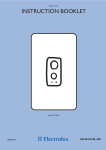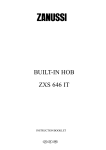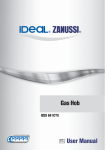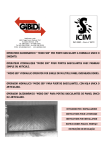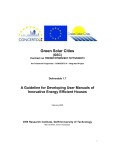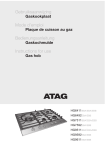Download Zanussi ZGF 983 Technical data
Transcript
TABLE DE CUISSON GASKOOKPLAAT GASKOCHMULDE GAS HOB ZGF 983 NOTICE D'UTILISATION GEBRUIKSAANWIJZING GEBRAUCHSANLEITUNG INSTRUCTION BOOKLET BE ENGLISH ☛ For Your Safety These warnings are provided in the interest of safety. You installing or using the appliance. MUST read them carefully before It is most important that this instruction book should be retained with the appliance for future reference. Should the appliance be sold or transferred, always ensure that the book is left with the appliance in order that the new owner can get to know the functions of the appliance and the relevant warnings. During Operation • • • • • • • • • This appliance has been designed to be operated by adults and children under supervision. Young children MUST NOT be allowed to tamper with the controls or play near or with the oven. This appliance has been designed for cooking edible foodstuff and to be used for domestic nonprofessional purposes only. It must not be used for any other purpose. It is dangerous to alter the specification in any way. For hygiene and safety reasons, this appliance should be kept clean at all times. A build-up of fats or other foodstuff could result in a fire. Accessible parts of this appliance may become hot when it is in use. Children should be KEPT AWAY until it has cooled. Under no circumstances should you attempt to repair the appliance yourself. Repairs carried out by unexperienced persons may cause injury or serious malfunctioning. Refer to your local Zanussi Service Centre. Always insist on genuine Zanussi spare parts. Ensure that all control knobs are in the OFF position when not in use. Should you connect any electrical tool to a plug near this cooking appliance, ensure that electric cables are not in contact with it and keep them far enough from the heated parts of this appliance. If the appliance is out of order, disconnect it from the electric supply. MANUFACTURER: ELECTROLUX ZANUSSI S.p.A. Viale Bologna 298 - 47100 FORLI’ (Italy) About Installation, Cleaning and Manteinance • • • • • • • • - It is mandatory that all operations required for the installation are carried out by a qualified or competent person, in accordance with existing rules and regulations. Disconnect the appliance from the electrical supply, before carrying out any cleaning or manteinance work. Ensure a good ventilation around the appliance. A poor air supply could cause lack of oxygen. Ensure that the gas supply complies with the gas type stated on the identification label, placed near the gas supply pipe. Using a gas cooking appliance will produce heat and moisture in the room which it has been installed in. Ensure a continuous air supply, keeping the air vents in good conditions or installing a cooker hood with discharge tube. In case of intensive or long time use of the appliance, make the ventilation more efficient, by opening a window or increasing the electric exhaust fan power. Once you removed all packaging from the appliance, ensure that it is not damaged and the electric cable is in perfect conditions. Otherwise, contact your dealer before proceeding with the installation. The manufacturer disclaims any responsability should all the safety measures not be carried out. This appliance complies with the following E.E.C. Directives: 73/23 - 90/683 (Low Voltage Directive); 89/336 (Electromagnetical Compatibility Directive); 90/396 (Gas Appliances) 93/68 (General Directives) and subsequent modifications. These instructions are only for the countries stated by the symbol printed on the front cover of this instruction book. 33 Contents 1. Instruction for the User ............. Pag. 34 5. Electrical Connection ................ Pag. 37 2. Cleaning and Maintenance ....... Pag. 35 6. Adaptation to different types of gas................................ Pag. 38 3. Technical Data ........................... Pag. 36 7. Building In .................................. Pag. 39 4. Instruction for the Installer ....... Pag. 36 Guarantee ................................... Pag. 42 1. Instruction for the User HOB BURNERS CONTROL KNOBS The hob burners control knobs are situated on the hob front panel. The symbols on the knobs mean that : ● Carefully supervise cookings with fats or oil, since these types of foodstuff can result in a fire, if over-heated. there is no gas supply there is maximum gas supply there is minimum gas supply LIGHTING THE BURNERS • For easier lighting, proceed before putting a pan on the pan support. Press the automatic ignition switch marked with a small spark. Push the relevant burner control knob down and turn it anti-clockwise until it reaches the "maximum" position. After lighting the flame, keep the knob pushed down for about 5 seconds. This will allow the "thermocouple" (Fig. 1 lett. D) to be heated and the safety device to be switched off, otherwise the gas supply would be interrupted. Then, check the flame is regular and adjust it as required. If you cannot light the flame even after several attempts, check the "cap" (Fig. 1 lett. A) and the "crown" (Fig. 1 lett. B) are in the correct position. To put the flame out, turn the knob to the symbol ●. • 34 FO 0204 Always turn the flame down or put it out before taking the pans off the burner. USING THE HOB CORRECTLY To ensure maximum burner efficiency, it is strongly recommended that you use only pots and pans with a bottom fitting the size of the burner used, so that flame will not spread beyond the bottom of the vessel (see the table beside). It is also advisable, as soon as a liquid starts boiling, to turn down the flame so that it will barely keep the liquid simmering. • Fig. 1 Use only pans or pots with flat bottom. Burner Double Crown Big (rapid) Medium (semirapid) Small (Auxiliary) minimum diameter 180 mm 160 mm 120 mm 80 mm maximum diameter 260 mm 260 mm 220 mm 160 mm THE HOB LID In order to make the appliance match with the kitchen design, a lid (not provided) can be fitted on the hob. ● Always clean the lid from cooking residues before opening it or taking it off. ● The lid is meant to avoid dust to settle on the hob, when it is closed, and to collect splashes of oil or fat, when it is open. Do not use it for any other purpose. ● WARNING! The crystal lid can splinter when overheated. Always ensure all the burners are off before closing it. ● Always wipe off any splash of liquid before opening the lid. 2. Cleaning and Maintenance • Disconnect the appliance from the electrical supply, before carrying out any cleaning or manteinance work. Wash the enamelled components with warm soapy water. Never use abrasive cleaners Frequently wash the "caps" and the "crowns" with hot soapy water, carefully taking away any built-up of food. Carefully wash the stainless steel components with water, then wipe them dry with a soft cloth. The pan supports are dishwasher proof. If the marks are particularly difficult to remove, use common non-abrasive cleaners or specific products. Never use steel wool pads or acids. In models provided with electric ignition, this feature is obtained through a ceramic "candle" and a metal electrode (fig. 1 lett. C). Keep these components well clean, to avoid difficult lighting, and check that the burner crown holes (lett. B) are not obstructed. FO 2347 PAN SUPPORTS To keep the pan supports in the right position, they are hooked to a couple of special hinges in the back of the hob. Thanks to these hooks, you can lift the pan supports for easier cleaning, as shown in fig. 2. To take the pan supports completely off the hob, proceed as shown in fig. 3. PERIODIC MAINTENANCE Periodically ask your local Service Centre to check the conditions of the gas supply pipe and the pressure adjuster, if fitted. To ensure the good operation of the hob and its safety features, it is necessary that the taps are periodically lubricated. Fig. 2 FO 2032 ● The periodic lubrication of the taps must be carried out by qualified personnel, which you must refer to also in case of malfunctioning. Fig. 3 35 3. Technical Data Gas Burners Rating Double Crown Burner 3,5 kW Rapid Burner (big) 3 kW (G20) - 2,8 kW (G30-31) Auxiliary Burner (small) Semirapid Burner (medium) Class 3 Appliance Category Setting 1 kW 2 kW II 2E+3+ Natural Gas 20 mbar / G25 25 mbar Gas connection Electric Supply HOB RECESS DIMENSIONS Length Width G 1/2" 230 V 50 Hz 830 mm. 480 mm. 4. Instruction for the Installer ● The side walls of the unit in which the hob is going to be installed, must not exceed the height of the working top. ● Avoid installing the appliance in the proximity of inflammable materials (e.g. curtains, tea towels etc.). ● The following instructions about installation and maintenance must be carried out by qualified personnel in compliance with the regulation in force. The regulation to be applied for this type of installation is NBN D 5I.003 : "Installations functioning with combustible gas lighter than air". ● The appliance must be electrically disconnected before all interventions. If any electric supply to the appliance is required to carry out the work, ensure all the necessary precautions are followed. A) Ramp with ending nut B) Seal C) Adjustable connection GAS CONNECTION It is indispensible that the connection to the gas mains are carried out by means of an AGB tap. Choose fixed connections or use a flexible pipe in AGB (stainless steel). If using flexible metallic pipes, be careful they do not come in contact with mobile parts or they are not squeezed. Use the same attention when the hob is combinated with an oven. This hob can be operated by Slochteren gas (G25) with a nominal pressure of 25 mbar or by natural gas with nominal pressure of 20 mbar. No regulation is required for use by these two types of gas. Before fitting the appliance ensure that the installation has the correct voltage for the appliance. At full capacity, the drop in pressure must not exceed 5%. Such a drop in pressure is caused by the following parameters: - maximum capacity of meter; - diameter and lenght of the tube in front and behind the meter; - section of transit of variuos tubes positioned on the circuit; - diameter of eventual connections. IMPORTANT - To ensure a correct operation, a saving of energy and the long-life of the appliance, the voltage pressure of the appliance must correspond to the recommended values. The adjustable connection is fixed to the comprehensive ramp by means of a threaded nut GJ 1/2". Interpose the sealing between the components as shown in fig. 4. Screw the parts without forcing, adjust the connection in the required direction and tighten everything. FO 2365 36 Fig. 4 IMPORTANT - When the final connection has been made, it is essential that a thorough leak test is carried out on the hob and installation. Use some soapy water, never a flame. 5. Electrical Connection The appliance is designed to be connected to 230 V monophase electricity supply. The connection must be carried out in compliance with the laws and regulations in force. Before the appliance is connected: 1) check that the main fuse and the domestic installation can support the load (see the rating label); 2) check that the power supply is properly earthed in compliance with the current rules; 3) check the socket or the double pole switch used for the electrical connection can be easily reached with the appliance built in the forniture unit. The appliance is supplied with a connection cable. This has to be provided with a proper plug, able to support the load marked on the identification plate. To connect the plug to the cable, follow the recommendation given in Fig. 5. The plug has to be fitted in a proper socket. If connecting the appliance directly to the electric system, it is necessary that you install a double pole switch between the appliance and the electricity supply, with a minimum gap of 3 mm. between the switch contacts and of a type suitable for the required load in compliance with the current rules. The connection cable has to be placed in order that, in each part, it cannot reach a temperature 90 °C higher than the room temperature. The brown coloured phase cable (fitted in the terminal block contact marked with "L") must always be connected to the network phase. Neutral Earth (yellow/green) REPLACEMENT OF THE VOLTAGE CABLE The connection of the voltage cable to the appliance's terminal block is of type "Y". This means that its replacement requires the specific equipment of a technician. In this case, only cable type H05V2V2-F T90 must be used. The cable section must be suitable to the voltage and the working temperature. The yellow/green earth wire must be approximately 2 cm. longer than the phase wires (Fig. 5). FO 0073 Fig. 5 To open the terminal block and reach the terminals, proceed as follows: ● insert the point of a screwdriver into the visible protrunding part of the terminal block; ● exert a light pressure and lift (Fig. 6) FO 0257 Fig. 6 37 6. Adaptation to different types of gas INJECTORS REPLACEMENT • • • Remove the pan supports. Remove the burner's caps and crowns. With a socket spanner 7 unscrew and remove the injectors (Fig. 7), and replace them with the ones required for the type of gas in use (see table 2). • Reassemble the parts, following the same procedure backwards. • Replace the rating label (placed near the gas supply pipe) with the relevant one for the new type of gas supply. You can find this label in the package of the injectors supplied with the appliance. Should the feeding gas pressure be different or variable compared with the required pressure, an appropriate pressure adjuster must be fitted on the gas supply pipe, in compliance with the rules in force. Fig. 7 FO 0392 ADJUSTMENT OF MINIMUM LEVEL To adjust the minimum level of the burners, proceed as follows: • Light the burner. • Turn the knob on the minimum position. • Remove the knob. • With a thin screwdriver, adjust the by-pass screw (see Fig. 8). If changing from natural gas to LPG, completely tighten clockwise the screw, until a small regular flame is obtained. • Finally check the flame does not go out when quickly turning the knob from the maximum position to the minimum position. This procedure can easily be carried out, anyhow the hob has been positioned or built in the working top. Fig. 8 FO 2031 Table 1 : By-pass diameters Burner Ø By-pass in 1/100 of mm. Double Crown Auxiliary Semi-rapid Rapid 56 28 32 40 Table 2 : injectors - (*) suitable for G25 too. BURNER REDUCED POWER kW kW NORMAL POWER NATURAL GAS G20 - 20 mbar inj. 1/100 m3/h LPG 28-30/37 mbar inj. 1/100 g/h - G30 g/h - G31 Auxiliary (small) 1 0,33 70(*) 0,095 50 72 71 Semi-rapid (medium) 2 0,45 96(*) 0,190 71 145 143 Natural gas : 3 LPG : 2,8 0,65 119(*) 0,286 86 203 200 3,5 1,2 136(*) 0,333 93 254 250 Rapid (big) Double Crown Burner 38 NORMAL POWER 7. Building In A = Auxiliary burner R = Rapid Burner SR = Semirapid burner UR = Double Crown Burner SR A These hobs can be inserted in a built-in kitchen unit whose depth is between 550 and 600 mm. The hobs dimensions are shown in Fig. 9. UR SR R 86 0 0 51 Fig. 9 FITTING THE LID We recommend the lid hinge block are fitted before installing the hob into the worktop. To install the lid onto the hob, proceed as follows: a. Remove the right and left hand grid blocks fitted to the back of the hob, by unscrewing the relevant screws (fig. 10) b. Fit the lid hinge blocks onto the hob, using the original screws, ensuring that the relevant shims are fitted between the hinge blocks and the hob (fig. 10); c. Fit the left hand lid hinge (marked S) into the hinge block (fig.11); d. Carry out the same operation with the right hand lid hinge (marked D). ADJUSTING THE LID BALANCE To adjust the lid balance, turn clockwise or anticlockwise the central screw of the right- and left-hand hinges (fig. 12). FO 2035 Fig. 10 FO 2037 FO 2036 Fig. 11 Fig. 12 39 30 55 m 480 These hobs can be installed in a kitchen unit with an opening for insertion whose dimensions are shown in Fig. 13. The edge of the cut out must have a minimum distance from the rear wall of 55 mm. If there are side walls, or sides of the furniture unit near the hob, the cut out edges must have a minimum distance of 150 mm. as shown in Fig. 13. in. INSTALLATION AND ASSEMBLY Carry out the building in of the hob as follows: 830 • put the relevant sealings, supplied with the hob, on the edges of the cut out, as shown in Fig. 14, taking care that the sealings meet without overlapping; 150 min FO 2349 • place the hob in the cut out, taking care of its Fig. 13 centring; • fix the hob with the relevant screws (Fig. 15). The traction of the screws is able to trace the sealing, any excess of which can then be easily removed. The edge of the hob forms a double labyrinth seal which provides a total guarantee against infiltration of liquids. FO 2348 Fig. 14 a FO 0199 a) Joint d'étanchéité 40 Fig. 15 Fig. 17 Fig. 16 a 60 591 Proper arrangements must be taken in designing the forniture unit, in order to avoid any contact with the bottom of the hob which can be heated when it is operated. The recommended solution is shown in Fig. 16. The panel fitted under the hob should be easily removable to allow an easy access if a technical assistance intervention is needed. 30 480 30 Kitchen unit with door 20 min POSSIBILITIES FOR INSERTION b 380 140 Kitchen unit with oven The hob recess dimensions must comply the indication given in Figs. 17 and 20 and must be provided with brackets to allow a continuous supply of air. To avoid overhating, the building in should be carried out as shown in Figs. 18 e 19. The hob's electric connection and the oven's one must be carried out separately, both for safety reasons and to allow the oven to be easily taken off the unit. Hanging forniture units or hoods must be placed at 650 mm. minimum from the hob (Fig. 21). FO 2044 FO 2043 a) Removable panel b) Space possibly useful for connections Fig. 19 Fig. 18 50 cm 2 120 cm 2 360 cm 2 FO 2041 180 cm 2 FO 2042 Fig. 21 Fig. 20 560 min. 650 min 550 min. FO 0198 FO 2350 41











